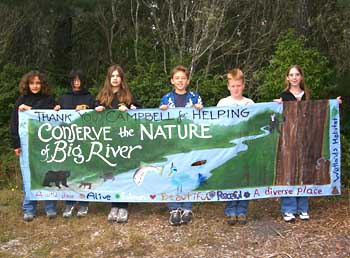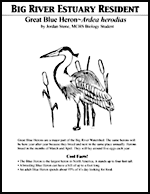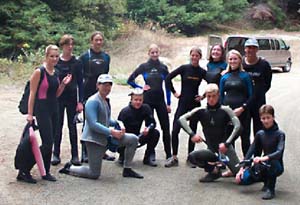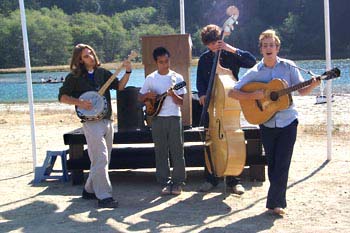 Saving the Big River Watershed in Mendocino, California
Saving the Big River Watershed in Mendocino, California fter a northern California timber company announced its harvesting plans for the Big River
watershed, the tiny community of nearby Mendocino embarked on a campaign of David and Goliath
proportions: saving the pristine acreage of river, estuary, wetlands, and forest by buying the property.
Although the logging company was not opposed to selling, the commercial value of the redwoods
growing there—upwards of $7 per board foot—made the $25.7 million asking price seemingly prohibitive.
Undeterred, the Mendocino Land Trust, a local conservation group, started mobilizing in public and
private arenas to raise the staggering sum.
fter a northern California timber company announced its harvesting plans for the Big River
watershed, the tiny community of nearby Mendocino embarked on a campaign of David and Goliath
proportions: saving the pristine acreage of river, estuary, wetlands, and forest by buying the property.
Although the logging company was not opposed to selling, the commercial value of the redwoods
growing there—upwards of $7 per board foot—made the $25.7 million asking price seemingly prohibitive.
Undeterred, the Mendocino Land Trust, a local conservation group, started mobilizing in public and
private arenas to raise the staggering sum.Mendocino students of all ages contributed to “the purchase,” as locals call it. With help from parents, teachers, and local artists, two high school alumni on break from college organized an art sale: hundreds of students K-12 created artwork about Big River, displayed it for five days at the local art center, then donated all proceeds to the purchase. Other students wrote letters to elected officials; middle schoolers made a banner displayed at many Big River events. And students in area high schools did their part, too.
Students first researched and wrote an in-depth report about one of the organisms on their inventory lists. They extrapolated from their report the most salient information—such as identifying features and behavior, habitat and range, reproduction and predation—to present on a poster with an appealing illustration or photograph. Students then tacked up posters of the kingfisher, trillium, coho salmon, and 17 other species all over town and posted them on the school district’s website . They wrote public service announcements published in the local newspaper and aired on radio that encouraged residents to read their posters—and to share the information they contained with a friend, colleague, or neighbor. The Mendocino Land Trust included four of the students’ posters in its Big River fundraising materials.
Their data proved the existence of both endangered salmon species in Big River—a finding students
wrote up in a research report and submitted to Fish and Game and the Mendocino Land Trust, who in
turn passed it on to officials in Sacramento. The report is credited with several million dollars worth of
the state’s commitment toward the Big River purchase.
On October 5, Land Trust officials, state park representatives, politicians, and area residents
young and old gathered on a sparkling day at the mouth of Big River to dedicate the new park.
A high school bluegrass band played on the riverbank before the ceremony. Elementary school
students helped hand out framed photographs given in appreciation to contributors.
Teenagers interviewed attendees and videotaped the ceremony—capturing a day and a
story worth remembering by us all.
Students in Mendocino County contribute to a number of other local water efforts: conducting water
quality tests, cleaning stream debris, propagating native species for watershed restoration,
and preserving local salmon and trout stocks. See in particular the following:
>>Restoring the Bronx River in New York City
>> Back to Water Works main page
|
 At Mendocino Community High School, a small alternative school, students in Daniel
Williford’s biology class set out to survey the Big River Estuary area to determine
what species the logging plan would affect. Hiking along ridgetops, the beach, and an old
logging road, they compiled a written inventory of the plant, animal, bird, and fish life they
encountered. When students discovered the number and variety of organisms living in the
area—over 130 species of birds alone, including spotted owls, golden and bald eagles,
herons, osprey—they felt the need to go public. After some discussion, the class settled
on a poster campaign.
At Mendocino Community High School, a small alternative school, students in Daniel
Williford’s biology class set out to survey the Big River Estuary area to determine
what species the logging plan would affect. Hiking along ridgetops, the beach, and an old
logging road, they compiled a written inventory of the plant, animal, bird, and fish life they
encountered. When students discovered the number and variety of organisms living in the
area—over 130 species of birds alone, including spotted owls, golden and bald eagles,
herons, osprey—they felt the need to go public. After some discussion, the class settled
on a poster campaign. After classroom and field training in identification techniques of the coho and steelhead salmon (both endangered
species), students donned wetsuits and snorkels to complete the transect study of four different 100-meter
sections of Big River. Accompanied by representatives from the timber company and from California Fish
and Game, students stretched in a line across the river to identify and count the numbers of steelhead
and coho darting among the eelgrass beds.
After classroom and field training in identification techniques of the coho and steelhead salmon (both endangered
species), students donned wetsuits and snorkels to complete the transect study of four different 100-meter
sections of Big River. Accompanied by representatives from the timber company and from California Fish
and Game, students stretched in a line across the river to identify and count the numbers of steelhead
and coho darting among the eelgrass beds.

 his past July, the Mendocino Land Trust finalized the purchase of 7,334 acres in the Big River
Watershed from the Hawthorne Timber Company, then transferred ownership to the California state
park system. The purchase permanently protects the Big River estuary and bordering forestland.
And by joining several adjacent state parks and preserves, it creates 60,000 acres of connected,
unspoiled public land.
his past July, the Mendocino Land Trust finalized the purchase of 7,334 acres in the Big River
Watershed from the Hawthorne Timber Company, then transferred ownership to the California state
park system. The purchase permanently protects the Big River estuary and bordering forestland.
And by joining several adjacent state parks and preserves, it creates 60,000 acres of connected,
unspoiled public land.